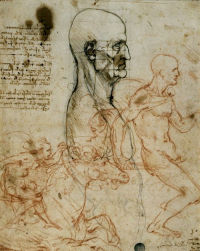Rule of Mathematics Click on the thumbnails to explore the trail
Read more about this trail (expand)
Leonardo believed that all things in nature were governed by mathematics. Mathematics was of supreme importance and expressed incontrovertible, universal truth. Knowledge of mathematics was a prerequisite for understanding the nature of all things. “Let no-one who is not a mathematician read my principles”, Leonardo said. Geometry and its actual or potential relationship to natural forms provided a suitably visual means for the exploration of mathematical “truths”.

- Enlarge
-
© Ministero per i Beni e le Attività Culturali, Polo Museale Veneziano
The facial proportions of a man in profile; study of soldiers and horses c1490-95 - 1503
Leonardo wanted to create an ideal of human proportions. The idea came from Plato and Vitruvius, who pointed out that the proportions of the human body were analogous to the parts of an ideal temple.
On this sheet, Leonardo notes the proportions of a man’s head. The drawing is an external counterpart to his Studies of the Human Skull. Comparison between the drawing and accompanying notes indicates that the drawn proportions have been calculated by eye and are not precisely constructed. Leonardo writes that “the join of the lower lip with the chin and tip of the jaw and the upper tip of the ear with the temple forms a perfect square”, but the squares drawn on the face are uneven.
The distinctive model - a mature, bald man with sharp facial features and a square jawline, suits the format of the linear perspective “box” applied to his features. He appears in other proportional drawings by Leonardo. He also seems to have provided inspiration for the nude horseman drawn in red chalk below sometime later, probably in preparation for the Battle of Anghiari fresco.
In Leonardo's words
...each side by itself is half the head. The hollow of the cheek-bone occurs half-way between the tip of the nose and the top of the jaw-bone, which is the lower angle of the setting on of the ear, in the frame here represented. From the angle of the eye socket to the ear is as far as the length of the ear, or the third of the face.
This sheet combines work from two different types by Leonardo, and illustrates how the artist was inclined to explore disparate interests on the same sheet, developing different ideas and concepts either in tandem or evolving new forms out of pre-existing ideas.
The pen and ink study of the proportions of a man’s face probably dates from c.1490-95 or sometime after the artist had set out to investigate the proportions and movements of the human figure around 1489-90. The disciplined precision of the pen and ink profile with its applied grid of lines contrasts markedly with the freely drawn, expressive studies in red chalk seen in the lower half of the drawing.
Two charging soldiers mounted on horses, relate to the cavalry in the little-known left part of Leonardo’s unfinished Battle of Anghiari, and as such reflect the early stages of the design process for that commission awarded to Leonardo in 1503.
The pen and ink profile head may have inspired the bald, nude figure seen on the right of the drawing, in which Leonardo’s knowledge of anatomy through repeated study of the life model is apparent. In the lower left corner of the sheet, Leonardo exploited the softness and light tonality of the red chalk to freely sketch a horse and rider, producing a powerful and dramatic sense of forward momentum.
- Medium Pen and ink over traces of stylus, black chalk, or charcoal, and red chalk
- Size 28 x 24.4 cm
- Location Galleria dell’Accademia











